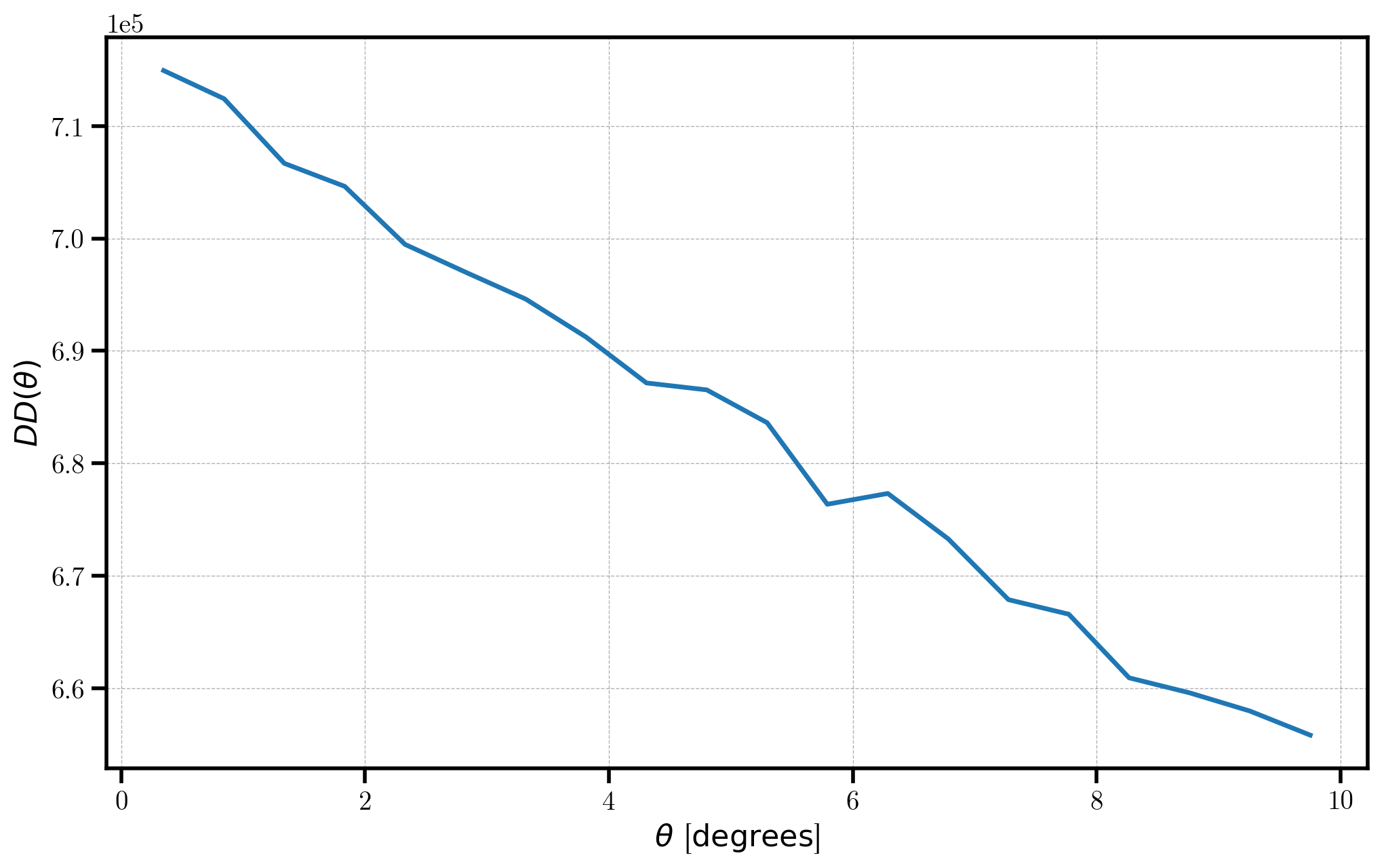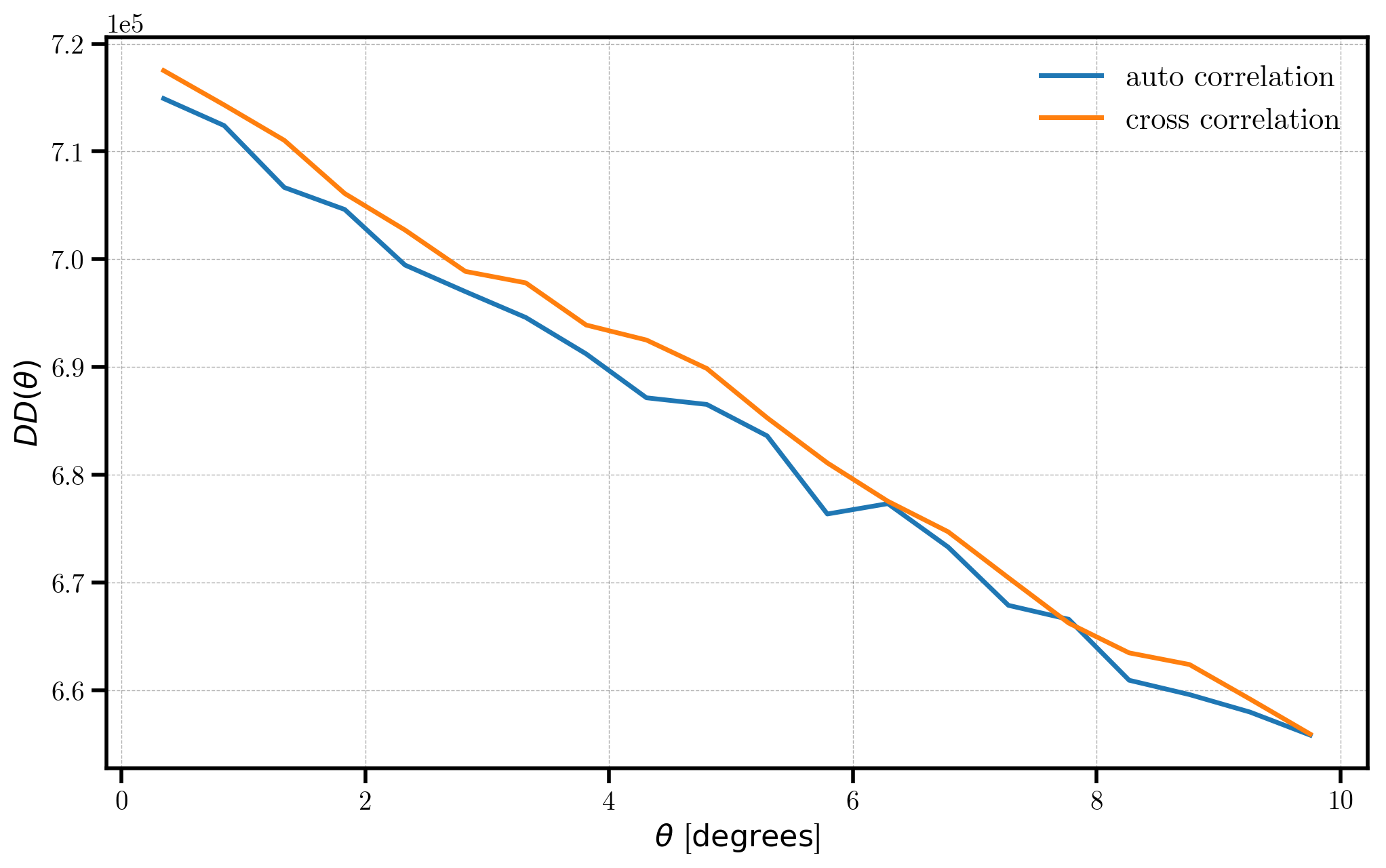Angular Pair Counting¶
In this notebook, we explore the functionality of the AngularPairCount algorithm, which computes the number of pairs in angular separation bins for survey-like input data, assumed to be angular sky coordinates (i.e., right ascension and declination).
Note
The data used in this notebook is not realistic – rather, we choose the simplicity of generating mock data to help users get up and running quickly. Although the end results are not cosmologically interesting, we use the mock data to help illustrate the various steps necessary to use the AngularPairCount algorithm properly.
[1]:
%matplotlib inline
%config InlineBackend.figure_format = 'retina'
[2]:
from nbodykit.lab import *
from nbodykit import setup_logging, style
import matplotlib.pyplot as plt
plt.style.use(style.notebook)
[3]:
setup_logging()
Initalizing Mock Data¶
In this notebook, we construct our fake “data” catalog simply by generating 10,000 objects that have uniformly distributed right ascension and declination values within a region of the sky.
[4]:
NDATA = 10000
# randomly distributed RA/DEC on the sky
data = RandomCatalog(NDATA, seed=42)
data['RA'] = data.rng.uniform(low=110, high=260)
data['DEC'] = data.rng.uniform(low=-3.6, high=60)
Adding Weights¶
The AngularPairCount algorithm also supports computing weighted pair counts. The total weight for a pair of objects is the product of the individual weights. Users can specify the name of column they would like to treat as a weight by passing the weight keyword to the algorithm constructor.
Here, we choose randomly distributed weights between 0 and 1.
[5]:
data['Weight'] = numpy.random.random(size=len(data))
Auto-correlation Pair Counts¶
To compute the pair counts, we simply specify the edges of the angular separation bins (in degrees), as well as the names of the columns holding the sky coordinates and weight values.
[6]:
# the angular bin edges in degrees
edges = numpy.linspace(0.1, 10., 20+1) # 20 total bins
# run the algorithm
r_auto = AngularPairCount(data, edges, ra='RA', dec='DEC', weight='Weight')
[ 000000.06 ] 0: 10-30 20:54 AngularPairCount INFO using cpu grid decomposition: (1, 1, 1)
[ 000000.08 ] 0: 10-30 20:54 AngularPairCount INFO correlating 10000 x 10000 objects in total
[ 000000.08 ] 0: 10-30 20:54 AngularPairCount INFO correlating A x B = 10000 x 10000 objects (median) per rank
[ 000000.08 ] 0: 10-30 20:54 AngularPairCount INFO min A load per rank = 10000
[ 000000.08 ] 0: 10-30 20:54 AngularPairCount INFO max A load per rank = 10000
[ 000000.08 ] 0: 10-30 20:54 AngularPairCount INFO (even distribution would result in 10000 x 10000)
[ 000000.08 ] 0: 10-30 20:54 AngularPairCount INFO calling function 'Corrfunc.mocks.DDtheta_mocks.DDtheta_mocks'
[ 000000.38 ] 0: 10-30 20:54 AngularPairCount INFO 10% done
[ 000000.70 ] 0: 10-30 20:54 AngularPairCount INFO 20% done
[ 000000.98 ] 0: 10-30 20:54 AngularPairCount INFO 30% done
[ 000001.26 ] 0: 10-30 20:54 AngularPairCount INFO 40% done
[ 000001.58 ] 0: 10-30 20:54 AngularPairCount INFO 50% done
[ 000001.94 ] 0: 10-30 20:54 AngularPairCount INFO 60% done
[ 000002.22 ] 0: 10-30 20:54 AngularPairCount INFO 70% done
[ 000002.52 ] 0: 10-30 20:54 AngularPairCount INFO 80% done
[ 000002.83 ] 0: 10-30 20:54 AngularPairCount INFO 90% done
[ 000003.13 ] 0: 10-30 20:54 AngularPairCount INFO 100% done
The measured paircounts are stored in the result attribute. The number of pairs in a given angular bin is stored as the npairs field. Below, we plot the number of pairs \(DD(\theta)\) as a function of angular separation.
[7]:
pc = r_auto.result
plt.plot(pc['theta'], pc['npairs'])
# format the axes
plt.xlabel(r"$\theta$ [$\mathrm{degrees}$]")
plt.ylabel(r"$DD(\theta)$")
[7]:
<matplotlib.text.Text at 0x112e080b8>
The total weight for a given pair is the product of their individual weights, and the average total weight is computed in each angular bin. This value is stored in the weightavg field of the result attribute. Below, we plot the average weight as a function of angular separation.
[8]:
plt.plot(r_auto.result['theta'], r_auto.result['weightavg'])
# format the axes
plt.xlabel(r"$\theta$ [$\mathrm{degrees}$]")
plt.ylabel(r"$\mathrm{average \ weight}$")
plt.ylim(0, 1.0)
[8]:
(0, 1.0)
Here, we chose to weight our objects with random values ranging from 0 to 1. Thus, on average, the expectation value of the square of those weights will be 0.25, which we see reproduced in the figure above.
Cross-correlation Pair Counts¶
We can also compute the cross-correlation of pair counts between two sources. Below, we initialize a second randomly distributed catalog, and compute the pair counts between the two catalogs.
[9]:
# randomly distributed RA/DEC on the sky
data2 = RandomCatalog(NDATA, seed=84)
data2['RA'] = data2.rng.uniform(low=110, high=260, size=len(data2))
data2['DEC'] = data2.rng.uniform(low=-3.6, high=60., size=len(data2))
data2['Weight'] = numpy.random.random(size=len(data2))
[10]:
# compute the cross correlation pair counts
r_cross = AngularPairCount(data, edges, ra='RA', dec='DEC', weight='Weight', second=data2)
[ 000006.07 ] 0: 10-30 20:54 AngularPairCount INFO using cpu grid decomposition: (1, 1, 1)
[ 000006.12 ] 0: 10-30 20:54 AngularPairCount INFO correlating 10000 x 10000 objects in total
[ 000006.12 ] 0: 10-30 20:54 AngularPairCount INFO correlating A x B = 10000 x 10000 objects (median) per rank
[ 000006.12 ] 0: 10-30 20:54 AngularPairCount INFO min A load per rank = 10000
[ 000006.13 ] 0: 10-30 20:54 AngularPairCount INFO max A load per rank = 10000
[ 000006.13 ] 0: 10-30 20:54 AngularPairCount INFO (even distribution would result in 10000 x 10000)
[ 000006.14 ] 0: 10-30 20:54 AngularPairCount INFO calling function 'Corrfunc.mocks.DDtheta_mocks.DDtheta_mocks'
[ 000006.44 ] 0: 10-30 20:54 AngularPairCount INFO 10% done
[ 000006.72 ] 0: 10-30 20:54 AngularPairCount INFO 20% done
[ 000007.00 ] 0: 10-30 20:54 AngularPairCount INFO 30% done
[ 000007.29 ] 0: 10-30 20:54 AngularPairCount INFO 40% done
[ 000007.59 ] 0: 10-30 20:54 AngularPairCount INFO 50% done
[ 000007.88 ] 0: 10-30 20:54 AngularPairCount INFO 60% done
[ 000008.16 ] 0: 10-30 20:54 AngularPairCount INFO 70% done
[ 000008.45 ] 0: 10-30 20:54 AngularPairCount INFO 80% done
[ 000008.74 ] 0: 10-30 20:54 AngularPairCount INFO 90% done
[ 000009.03 ] 0: 10-30 20:54 AngularPairCount INFO 100% done
[11]:
# plot the auto and cross pair counts
pc_auto = r_auto.result
pc_cross = r_cross.result
plt.plot(pc_auto['theta'], pc_auto['npairs'], label='auto correlation')
plt.plot(pc_cross['theta'], pc_cross['npairs'], label='cross correlation')
# format the axes
plt.legend(loc=0)
plt.xlabel(r"$\theta$ [$\mathrm{degrees}$]")
plt.ylabel(r"$DD(\theta)$")
[11]:
<matplotlib.text.Text at 0x1198cff28>


